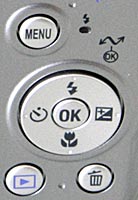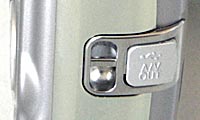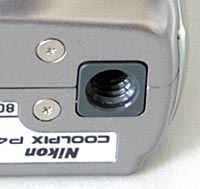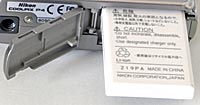Nikon Coolpix P4 Review
Review Date: April 19th 2006
Leave a Comment about this Review
|
Ease of Use
The Nikon Coolpix P4 isn't going to win any awards for good looks, with a look and feel that is more practical than stylish. At 9cms wide and 3cms deep, the Nikon Coolpix P4 is bigger than it looks in the glossy product shots, but it will fit into your trouser or shirt pocket. Most of the Coolpix P4 has an understated matt silver finish, with the sides of the body in a more glossy metal. The Nikon Coolpix P4 is fairly heavy for this class of camera when the battery and memory card are fitted (170g), but I actually consider this to be a plus point, as it gives the camera a reassuring heft and feel. The Nikon Coolpix P4 is very well-made overall, although there are a few external controls that aren't particularly well designed. The A/V Out Port cover is located in a very strange position on the right side of the body, next to the strap eyelet, where it protrudes slightly from the front of the camera. More annoyingly, the plastic tripod socket is positioned in the bottom-left corner of the camera, which doesn't make it very stable on a tripod. Lastly, the On/Off button is very small and recessed, which may prevent the camera from being accidentally turned on, but also makes it difficult to operate. None of these things actually stop the camera from working, but they are out of place at this price-point.
The Nikon Coolpix P4 is not overly complex in terms of the number of external controls that it has, despite offering advanced functionality and features. I counted just 10 controls in total, which suits the small size of the camera. The majority of the controls are clearly labeled and common to most cameras. There's a traditional dial on the top of the P4 that lets you select the various shooting and scene modes, plus the Setup menu option. This dial is a typical feature of SLR cameras, and enables you to quickly change between the various modes. Interestingly Nikon have included options for image quality, ISO speed and white balance. It's good to see a manufacturer making commonly used features more accessible - having these options on the exposure mode dial speeds up the camera operation. Also found on the top of the camera are the on/off button, shutter button and the vibration reduction button.
| Vibration Reduction Button / Exposure Mode Dial | Menu Button / Navigation Pad / Play Button / Delete Button |
 |
 |
If you have never used a digital camera before, or you're upgrading from a more basic model, reading the easy-to-follow manual before you start is a good idea. Thankfully Nikon have chosen to supply it in printed format (134 pages), rather than as a PDF on a CD, so you can also carry it with you. The large 2.5 inch LCD screen is the only way of framing your shots, so if you have to have an optical viewfinder, look elsewhere now. Nikon have used a great anti-reflective cover on the screen, which also seems to make fingerprints less visible. The various icons used to represent the camera settings are clear and legible, although you can only toggle the information on and off via the Setup menu on the exposure mode dial.
Nikon have introduced a new menu system for their 2006 Coolpix's, and very good it is too. The main menu system on the Nikon Coolpix P4 is straight-forward to use and is accessed by pressing the Menu button on the rear of the camera. You can choose either an icon or text-based system. The text menu has 3 screens with 5 options on each screen. The icon system shows all the options on a single screen and is the method that I preferred. Due to the large 2.5 inch LCD screen and restricting the number of on-screen choices to five (in the text version), the various options and icons are clear and legible. There is also a built-in Help system, accessed by pressing the Telephoto zoom button, which gives a brief but useful explanation for each option.
| Strap Eyelet / A/V Out Port | Tripod Mount |
 |
 |
There is one innovative feature on the Nikon Coolpix P4 that aims to make life easier for you. This camera is one of the first Nikon compacts to feature an anti-shake system, dubbed Vibration Reduction. Turn it on and the Nikon Coolpix P4 automatically compensates for camera shake, which is a slight blurring of the image that typically occurs at slow shutter speeds. There are two different modes, VR is is suitable for normal shooting and is best for panning shots, whilst VR Active is better for severe camera shake, such as shooting from a moving vehicle (but it has no effect when panning). In practice I found that that the Vibration Reduction feature does make a noticeable difference, as shown in the examples on the Image Quality page. You don't notice that the camera is actually doing anything different when anti-shake is turned on, just that you can use slower shutter speeds than normal and still take sharp photos. However, what Nikon gives you in the form of an effective anti-shake system, it takes away by only providing a limited ISO range of 50-400. This essentially means that you really need to leave the anti-shake system turned on all the time to compensate for the slow shutter speeds, especially as ISO 400 exhibits quite a high level of noise (see the Image Quality page), which negates some of the advantages that the anti-shake system offers. Thankfully leaving the anti-shake system on didn't negatively affect the battery-life, with the camera managing over 250 shots using the supplied rechargeable battery.
The Nikon Coolpix P4 offers the now well-established D-Lighting and Face Priority AF features. Do they actually work? Face Priority AF is accessed by selecting the Scene option on the shooting mode dial, pressing the Menu button and then choosing the Portrait (Face AF) option on the top row. It works well if the subject is looking directly at the camera and quite central in the frame, but in most other situations the camera hunts for focus for several seconds and then tends to focus somewhere other than the subject's face. I suspect that most users will quickly lose patience with this feature, as will the person who is being photographed! D-Lighting lightens under-exposed parts of the image whilst ensuring that correctly exposed parts remain the same (and are not also lightened) - more on this feature in the Image Quality section.
The Nikon Coolpix P4 offers an aperture priority mode for advanced photographers who want more control. Nikon have implemented a very neat way of changing the aperture and dialing in exposure compensation. Simply press the right button on the Navigation pad and you can set the aperture using the right and left buttons and the exposure compensation with the up and down. At the same time a small histogram is displayed which shows the effects of your changes - a clever system that works extremely well. Unfortunately there is no shutter-priority mode (or full manual), which makes the Nikon Coolpix P4 less suited to creative action photography - you have to rely on the Sports scene mode to get things right instead.
| Battery Compartment | Memory Card Slot |
 |
 |
The start-up time from turning the Nikon Coolpix P4 on to being ready to take a photo is quite quick at around 1.5 seconds. Zooming from the widest focal length to the longest takes about 2 seconds. Focusing is quick in good light and the camera achieves focus most of the time indoors or in low-light situations, helped by the focus-assist lamp. Note that the camera does struggle to lock onto the subject sometimes at the tele-photo end of the lens in low-light situations. The visibility and refresh rate of the 2.5 inch LCD screen are perfectly acceptable. It takes about 1 second to store an image, allowing you to keep shooting as they are being recorded onto the memory card, with a very brief LCD blackout between each image. The Nikon Coolpix P4 has a fairly slow Continuous mode which enables you to take 1.8 frames per second at the highest JPEG image quality, up to a maximum of 5 images. Overall the Nikon Coolpix P4 is average in terms of operational speed.
Once you have captured a photo, the Nikon Coolpix P4 has a fairly good range of options when it comes to playing, reviewing and managing your images. You can instantly scroll through the images that you have taken, view thumbnails, zoom in and out up to 10x magnification, view slideshows, delete, protect, trim and resize an image. You can also list all photos by date, apply D-Lighting to a copy and set the print order. Annoyingly you can't view detailed information such as the ISO rating and aperture / shutter speed, and there is no histogram available during playback. You can only choose between the detailed information, gridlines to aid composition and no information via the Setup menu.
In summary the Nikon Coolpix P4 is a compact digital camera that's straight-forward to use, fairly responsive and which offers some innovative and effective features.
|
